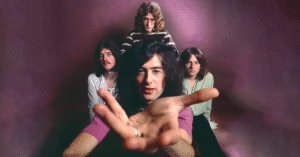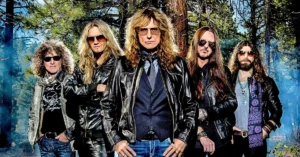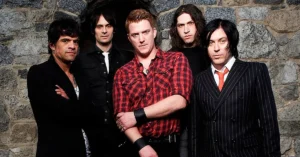Deep Purple: Pioneers of Heavy Rock and Progressive Fire
Deep Purple. From Experimentation to Power: The Early Years (1968–1969)
Deep Purple was formed in Hertford, England, in 1968 by session guitarist Ritchie Blackmore, keyboard wizard Jon Lord, bassist Nick Simper, drummer Ian Paice, and vocalist Rod Evans. Originally called Roundabout, the band quickly changed its name to Deep Purple — inspired by a song loved by Blackmore’s grandmother.

Their early output blended psychedelic rock, classical influences, and pop sensibilities, creating a unique sound in an evolving rock landscape.
Deep Purple. Early Albums:
- Shades of Deep Purple (1968) – Included the hit cover “Hush,” showcasing Lord’s classical leanings and Blackmore’s guitar edge.
- The Book of Taliesyn (1968) – Continued their blend of rock and classical with originals and covers like “Kentucky Woman.”
- Deep Purple (1969) – Showed a move toward a more sophisticated style with the orchestral-rock blend in “April.”
These albums laid the groundwork, but the real transformation was yet to come.
Mark II Lineup and Classic Era (1969–1973)
In mid-1969, Deep Purple replaced Rod Evans and Nick Simper with Ian Gillan (vocals) and Roger Glover (bass). This lineup, known as Mark II, would define the band’s golden years.
Concerto for Group and Orchestra (1969)
Jon Lord’s ambitious project with the Royal Philharmonic Orchestra was a bold fusion of rock and classical. Though divisive, it pushed boundaries and showed the band’s artistic ambition.
In Rock (1970)
A seismic shift. “Speed King” and “Child in Time” introduced a rawer, heavier, and more aggressive Deep Purple. Gillan’s vocal power and Blackmore’s guitar intensity birthed a new sound — proto-metal with progressive flourishes.
Fireball (1971)
More experimental, with elements of funk and odd time signatures. While not as commercially successful, it features standout tracks like “The Mule” and “Strange Kind of Woman.”
Machine Head (1972)
Their masterpiece. Featuring “Smoke on the Water”, “Highway Star”, and “Lazy”, this album cemented their place among rock’s elite. It combined virtuosity with anthemic songwriting and captured their live power in the studio.
Made in Japan (1972)
One of the most legendary live albums in rock history. Capturing their intensity and improvisational skill, it proved Deep Purple was a tour de force on stage.
Who Do We Think We Are (1973)
Despite hits like “Woman from Tokyo,” tensions grew. Gillan and Glover left after growing frustrated with internal conflicts, especially with Blackmore.
Mark III and IV: Funk, Soul, and Hard Rock (1973–1976)
In 1973, David Coverdale replaced Gillan on vocals and Glenn Hughes joined as bassist/vocalist, ushering in a funkier, bluesier era.
Burn (1974)
Showcased Coverdale and Hughes’ vocal chemistry and introduced a groovier sound. The title track and “Mistreated” became live staples.
Stormbringer (1974)
Delved further into funk and soul influences, which Blackmore disliked. He left the band in 1975, frustrated by the stylistic direction.
Come Taste the Band (1975)
Guitarist Tommy Bolin replaced Blackmore. Though Bolin was a gifted player, the album’s fusion of rock, soul, and funk was divisive. Tragically, Bolin died of a drug overdose in 1976, and the band officially disbanded the same year.
The Reunion: Mark II Returns (1984–1989)
After an eight-year hiatus, the classic lineup reunited for:
Perfect Strangers (1984)
A triumphant return. The album combined the power of 70s Purple with 80s production, and the title track became an instant classic.
The House of Blue Light (1987)
Tried to modernize the Purple sound but lacked the cohesion of its predecessor.
However, internal conflicts resurfaced, especially between Gillan and Blackmore. Gillan was fired in 1989 and replaced by Joe Lynn Turner (ex-Rainbow).
Deep Purple. 1990s–2020s: Evolving Through Change
Gillan returned in 1992 for The Battle Rages On, but tensions with Blackmore ended with Blackmore leaving Deep Purple for good in 1993. He was replaced temporarily by Joe Satriani, then permanently by Steve Morse in 1994.
Deep Purple. Later Albums with Morse:

- Purpendicular (1996) – Fresh, melodic, and critically acclaimed.
- Abandon (1998) – Harder-edged and darker in tone.
- Bananas (2003) – Showed surprising energy and variety.
- Rapture of the Deep (2005) – Merged their past with new textures.
- Now What?! (2013) – Marked a return to progressive grandeur.
- inFinite (2017) – Mature, reflective, and energetic.
- Whoosh! (2020) – Celebrated their legacy while sounding modern.
- Turning to Crime (2021) – A covers album paying tribute to their musical influences.
In 2022, Steve Morse left the band to care for his ailing wife, and Simon McBride was announced as the new guitarist.
Deep Purple. Musical Style and Influence
Deep Purple’s style evolved over time, but key elements remain:
- Classical-meets-rock experimentation (especially via Jon Lord)
- Heavy, riff-based hard rock (especially in the Mark II era)
- Funk, soul, and blues fusion (Mark III and IV eras)
- Progressive rock and jam-band elements
- Legendary live improvisation and solo battles on stage
Their influence is felt in metal, prog rock, hard rock, and even alternative and grunge. Bands like Metallica, Iron Maiden, Dream Theater, and Van Halen cite Deep Purple as a major inspiration.
Full Studio Discography
- Shades of Deep Purple (1968)
- The Book of Taliesyn (1968)
- Deep Purple (1969)
- In Rock (1970)
- Fireball (1971)
- Machine Head (1972)
- Who Do We Think We Are (1973)
- Burn (1974)
- Stormbringer (1974)
- Come Taste the Band (1975)
- Perfect Strangers (1984)
- The House of Blue Light (1987)
- Slaves and Masters (1990)
- The Battle Rages On (1993)
- Purpendicular (1996)
- Abandon (1998)
- Bananas (2003)
- Rapture of the Deep (2005)
- Now What?! (2013)
- inFinite (2017)
- Whoosh! (2020)
- Turning to Crime (2021)
Legacy
- One of the “unholy trinity” of British hard rock (with Black Sabbath and Led Zeppelin)
- Estimated to have sold over 100 million albums worldwide
- Inducted into the Rock and Roll Hall of Fame in 2016
- Known for elevating the Hammond organ to a lead instrument in hard rock
- Their live performances remain legendary, with ever-evolving setlists and improvisation
Interesting Facts
- “Smoke on the Water” tells the true story of a fire in Montreux, Switzerland, during a Frank Zappa concert.
- Ian Paice is the only member to appear on every Deep Purple album.
- Ritchie Blackmore went on to form Rainbow, and later the Renaissance-inspired Blackmore’s Night.
- Glenn Hughes overcame drug addiction and became a vocal powerhouse in the 2000s.
- In 2009, Deep Purple played a historic concert in Pyongyang, North Korea, with Ian Gillan participating in a cultural exchange.
Final Thoughts
Deep Purple’s ability to evolve through decades, maintain technical brilliance, and remain fearlessly innovative makes them one of rock’s most enduring and influential acts. From baroque experiments to arena-filling riffs, their sound has helped shape the DNA of modern rock and metal. And they’re still turning up the volume — loud, proud, and Purple.





